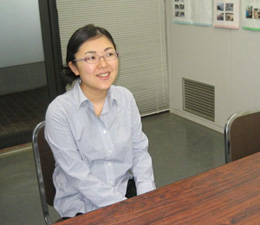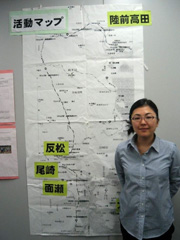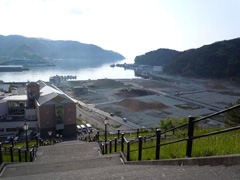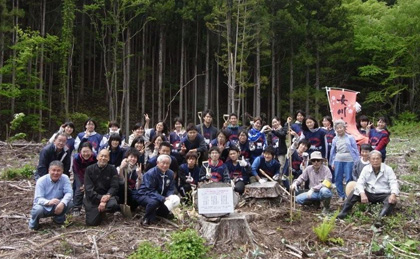Top>HAKUMON Chuo [2013 Summer Issue]>To find more volunteers
 Index
Index
To find more volunteers
~Mariko Matsumoto, first Volunteer Coordinator at Chuo University~

Ms. Mariko Matsumoto [profile]
The Chuo University Volunteer Station was established on April 1st as a source of support for students who wish to participate in volunteer activities. The highly-experienced Mariko Matsumoto was appointed to serve as Volunteer Coordinator, the face of the station. In May, a tour was held of disaster sites from the Great East Japan Earthquake, and Matsumoto worked hard to ensure that people will never forget the terrible disaster.
Text & Photographs by student reporter Shimon Sawada (2nd-year student in the Faculty of Policy Studies)
What are the duties of a Volunteer Coordinator? Matsumoto gave a clear answer to this question:
“Students have the strong desire to participate in activities for contributing to society. However, some students don’t know where to start or how to become involved in volunteer activities. My job is to link such students with communities which need help from students. Instead of simply showing students a catalog of volunteer groups, I listen to what students have to say and search together with them for the most appropriate volunteer activities.”
Matsumoto placed particular emphasis on the word “together.”
Motivation through experience as a student
Before being appointed to her position at Chuo University, Matsumoto was involved in support for construction from the Great East Japan Earthquake. She worked at Onagawa-Kogakukan Tutoring School in Onagawa Town, Miyagi Prefecture. The school was opened to help children with their studies and provide emotional care. Kogakukan is funded by donations gathered by the NPO Katariba and supports children in disaster areas through joint operation with the community. Matsumoto worked as a Community Coordinator at the school. Her job was to assess the constantly-changing needs of the disaster area and to implement appropriate support activities.
When Matsumoto was a student at Meiji University, she wasn’t as active as she is now. Instead, she concentrated only on her studies. “I felt that it was a waste not to get involved in more things,” she says. She overcame her feelings of hesitation and galvanized herself to dive into the world outside of university.
Her first step was to become involved in Campal, a student newspaper published by the Mainichi Newspapers. Although she entered the project with the intention of doing illustrations instead of writing articles, she was suddenly ordered to become a reporter. The first article which she wrote generated a big response from readers. Matsumoto felt the appeal of trying new things. The scope of her interest broadened and she embraced a variety of new challenges.

Matsumoto then founded an NPO with her friends. The group helps high school students take the initiative for selecting their own path of study and work. This was Matsumoto’s first experience with volunteer activities. “In order for society to change, it is first necessary for individuals to change,” she explains. “I wanted to create a better society.”
However, society showed little recognition for NPOs and volunteer groups. Matsumoto was often turned away at the door when she attempted to explain about her NPO. “Of course, it takes time for new things to be accepted,” she says. “I think that encountering such barriers in society helps young people to grow into adults.”
At this point in her life, Matsumoto wasn’t sure that she wanted to pursue a career in volunteer activities.
“I met more people during my 4 years at university than in the previous 18 years of my life,” Matsumoto explains. “While searching for employment, I felt the desire to work directly with people and support their goals.”
Matsumoto obtained certification as a social education supervisor, which she hoped would help her pursue her desired career. After graduation, she obtained employment at a community center in Chiba Prefecture where she was involved in town-building.
Afterwards, she spent 5 years working as a reporter at the community newspaper Funabashi Yomiuri (circulation of approximately 125,000 copies). In this position, she conveyed information on people working to improve the community.
Then the tragic earthquake of March 11th occurred. Matsumoto was shocked by this disaster which devastated the community and felt the desire to support recovery. In October, she traveled to Onagawa Town and began full-time work at the collaboration school run by the NPO Katariba.
In early winter of last year, Matsumoto heard from an acquaintance that the position of Volunteer Coordinator was open at Chuo University.
Matsumoto says that entering employment at Chuo University was a difficult decision. While working in the disaster area, she felt a fading sense of crisis. The amount of reporting from Tokyo on disaster areas was decreasing. Heavy coverage was given only to the Fukushima Daiichi Nuclear Power Plant and other great tragedies. At the community level, there was a new problem of discrepancies between prospective volunteers and the needs in disaster areas. Matsumoto strongly felt that current conditions in disaster areas weren’t being conveyed to Tokyo.
Matsumoto decided to move to Tokyo and use her knowledge of current conditions in disaster areas. She saw herself working as a pipeline to increase understanding towards volunteer activities needed in disaster areas.
Her decision was clinched when she remembered the hesitation which she had felt when she was a university student. When Matsumoto was a student, she impatiently felt that she should be doing more in her life and she had a passion for giving her full effort for the good of society. She decided that she wanted to encourage students who were struggling with hesitation to take the important first step.
“Volunteers face many issues for which there is no easy solution,” says Matsumoto. “Volunteering involves human relationships, social issues and contradictions. Sometimes it feels like you will crumble under the pressure. However, I hope that students will grow by confronting such harsh realities. Such growth is essential for contributing to the future of society and themselves as well as for becoming a true volunteer.”
The desire to bring together the passion of students and the needs of disaster areas in Tohoku led Matsumoto to accept the position of Volunteer Coordinator.
Creating opportunities
NPOs are the 3rd most popular
Popular employers for American university students studying the humanities are as follows:
1. The Walt Disney Company Ltd.
2. United Nations Headquarters
3. NPOs
4. Google
5. Department of State
*According to a program broadcast by NHK
Through exchange of information on Facebook, this new form of Chuo University volunteer activities has attracted the attention of more than 800 people (as of June). Through cooperation with social welfare councils in Hachioji and Hino, Matsumoto gathered information on local volunteer activities. In May, she held a study tour of disaster areas.
“Actively participating in society will help students improve their abilities so that they are able to make an immediate contribution when they start working,” explains Matsumoto. “My goal is simple—I want to create many such opportunities for students.
As the sole Volunteer Coordinator at Chuo University, Mariko Matsumoto has great expectations for students and deep knowledge of volunteer activities. Indeed, these qualities have the potential to generate great attention and results.
- Ms. Mariko Matsumoto
- Born in Funabashi City, Chiba Prefecture on September 26th, 1981. Graduated from Chiba Prefectural Funabashi-higashi High School and the Meiji University School of Political Science and Economics. The elder of 2 sisters. Describes herself as a student who always gets her homework done first.
-
Disaster Area Study Tour in Onagawa Town, Miyagi Prefecture

Onagawa Town viewed from above
Almost two and a half years have passed since the Great East Japan Earthquake. Many people may hold the mistaken impression that volunteers are no longer needed. However, in order to help as many students as possible see the true need for volunteers, a disaster area study tour was held in Onagawa Town, Miyagi Prefecture from May 24th to 26th. The 25 students who went on the tour were all 1st-year students and had never been to the disaster area.
Onagawa Town lost 10% of its population and 80% of its buildings were destroyed. The town suffered the greatest devastation of any municipality within Miyagi Prefecture. When gazing down on the town from high ground, the area is covered with vacant plots of land. It is hard to envision that people once led their daily lives here. It is also difficult to imagine the horror of March 11th or the way in which people will reconstruct their lives.
Study tour members spoke with local citizens of various ages and positions. For example, we talked with members of Onagawa Cherry Blossom Association, a group which seeks to reconstruct an appealing town by planting cherry blossoms which are the official tree of Onagawa Town, the owner of a shop in the temporary shopping area, citizens in their 20s who had returned from Tokyo after the earthquake in order to help with construction, a man who was rescued after being washed away by the tsunami, and high school students who want to contribute to their hometown.
“I want this shop to become a beacon of light for Onagawa Town, Tohoku, Japan and the world.”
“I pray that no one else ever has to experience such sadness. I hope that my experience with the disaster will be of use to others.”
“Thank you for coming to Onagawa. I hope that you will watch over our reconstruction.”
Citizens of Onagawa Town have felt the pain of losing loved ones. They have coped with life in cramped temporary housing. They have experienced standing at the crossroads of life. However, they have endured to dream of building a new town. The citizens spoke strongly on how they want others to apply the lessons learned from the earthquake.
Students learned much from the citizens of Onagawa Town.
“I realized that anyone can be a victim of disaster.”
“I learned about hard work and dedication from the people of Onagawa.”
“Before visiting Onagawa, I thought that volunteer activities involved giving special consideration to disaster areas and providing services to people in need. However, my view was extremely one-sided. Now, I realize the importance of working together with the community.”
Students also began to seriously consider how they can help.
Through the study tour, the people of Onagawa Town taught students the essence of volunteering—to start by doing whatever you can.
I am extremely grateful to the friendly citizens of Onagawa Town who took time from their busy lives to spend with students.

Students from the disaster area study tour and members of the Onagawa Cherry Blossom Association (Volunteer Coordinator Matsumoto at left)
Ms. Mariko Matsumoto
Volunteer Coordinator
(Photograph by the Chuo University Volunteer Station)
- Research Activities as a Member of Research Fellowship for Young Scientists (DC1), Japan Society for the Promotion of Science (JSPS) Shuma Tsurumi
- Important Factors for Innovation in Payment Services Nobuhiko Sugiura
- Beyond the Concepts of Fellow Citizens and Foreigners— To Achieve SDGs Goal 10 “Reduce Inequality Within and Among Countries” Rika Lee
- Diary of Struggles in Cambodia Fumie Fukuoka
- How Can We Measure Learning Ability?
—Analysis of a Competency Self-Assessment Questionnaire— Yu Saito / Yoko Neha - The Making of the Movie Kirakira Megane








